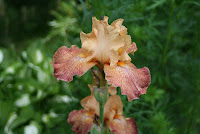To
Our Members:
Please feel welcome to bring family, friends, and supervised
children. Please leave pets at home. You are invited to visit these private
gardens on the listed date from 2:00-4:00 pm. Please feel free to ask questions
and take notes. Please do not pick weeds or flowers without permission. Take a map of the area you are visiting.
To Our Hosts:
Please place balloons or signage to mark
your property; use ribbon or twine to mark out of bounds areas. Please be
available on site to answer any questions. tours will take place, rain or
shine, from 2:00-4:00 pm. Visitors may ask for the names of plants; if you do
not know maybe other gardeners will. Relax and enjoy showing your hard work.
Feel free to attend all other gardens in the Summer Garden Tour.
Ø June 24 - Summerside - The Summerside Garden Club invites everyone to their tours. This
tour is from 1:00 to 4:00pm
·
Peter Jendrick - 74
Granville St
This is the street that has the malls.
·
Tom and Betty Hall - 705
Water Street
Coming in to Summerside on Water Street East, the Halls are on the
right past the Cairns Motel.
·
Toy and Sandy Gallant
117 Bay Ave As you come in to Summerside on Water St East, Bay Ave
is on your right just past the Halls.
·
Yvon and Mavis Arsenault -
79 Balcom Dr
As you come in to Summerside on water St, turn right at the lights
at MacEwen Rd; Balcom Dr is on your right.
·
Elma Sonier - 83 MacDonald
Crescent
Drive through Summerside on Water St and turn left on Bayview
Drive just past John's Nursery. Turn
right on to Spruce Drive (first right) to Tupper drive (on right), then on to
MacDonald Crescent on the left.
Sunday July 8 -
Charlottetown:
·
Cathy, Lois, Gemma and Judy
Callaghan - 153 Mason Road, Stratford
Turn left on to Rte 21 off the Hillsborough Bridge from Charlottetown.
turn right on to Mason Rd. See lots of hosta
·
Cathie and Brian Arsenault -
10 Kelly Court, Charlottetown
Going NW on North River Road turn on to Warburton Dr just past
Skyview Dr. Kelly Ct is on your right.
·
Lynn Gorveatt - 26 Skyview
Dr, Charlottetown
Going NW on North River Road, Skyview is just past Belvedere Ave;
house is on the right.
·
Pat and Peter LeGrow - 19
Woodlands Blvd, Elliot Park, Cornwall
Heading west on the TCH, you turn left
on to 248 (York Point Road) then right on to continuation of 248 (Ferry Road).. Eliot Park is on the right and Woodlands Blvd is the second left.
·
Portshell Crafts - Morley and Marilyn LeBelle - 250 Long Creek
Rd, Rte 19A
From Cornwall take Rte 19 over the West River Bridge continuing on
19A past a service station on the right. Look for a green house on the right
about 1.5 km past the service station.
·
Don and Beverley Ridley -
6077 Rte 19, Rice Point -From Cornwall take Route 19 over the West River bridges continuing
on Rte 19A past Gas's ESSO station. Continue on Route 19A (past Portshell
Crafts) until you reach the old yellow Canoe Cove school house. Turn left on to
Route 19 and continue 2 km. Ridley home is on the right and is the first paved
driveway past Highland Park Road. There are grey wooden posts making the drive.
Please park on the road.
Sunday July 22- Charlottetown
Area :
- Denise
Motard - 58 Nottinghill Dr - Stratford
On TCH
turn right at light at Sobeys on to Kinlock Rd. Proceed to Stratford Rd and
turn left. Nottinghill Dr is the first street on the right and house is near
the end of the street on the left
·
Doreen and Gordon Fraser -
20 Carvell Ct - Charlottetown
On Belvedere Ave between North River Road and Queen Street take
Atlantic Rd (next to Island Tel). Carvell Ct is the second street on the right.
·
Cranford Inn - 177 Fitzroy
St Charlottetown
·
Maureen and Stu Constable -
124 Southland Drive - Hillsborough Park Charlottetown
From the Charlottetown bypass proceed to the lights take South Gate Lane then turn
right on to Patterson Dr. The second street on the right is Southland Drive.
·
Jean and Dale Mader - 23
Lighthouse Lane, Bellvue Cove (Stratford) - On
TCH turn right at Sobeys on to Kinlock Rd. Proceed to Keppoch Rd and turn
left.Lighthouse lane is on the right.


























